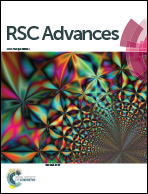Template-free assembling Ni nanoparticles to a 3D hierarchical structure for superior performance supercapacitors†
Abstract
Nanoflake arrays of Ni nanoparticles were assembled by template-free methods, including metal hydroxide arrays grown in situ on Ni foams and the following non-contact Al-reduction processes. After electrochemical activation, they achieved superior specific capacitances and excellent rate capabilities, owing to their good electric conductivity and mass transport properties.


 Please wait while we load your content...
Please wait while we load your content...